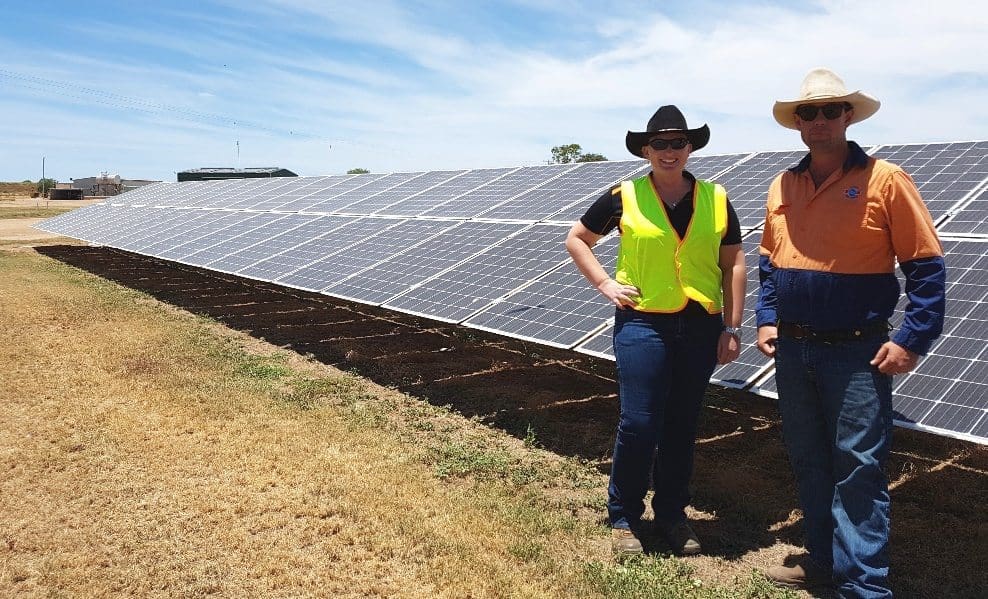
Teys Condamine feedlot manager Phillip Lambert and a staffmember in front of a small port of the yard’s new 1034 panel solar array.
WHAT is possibly the largest solar power generation project yet seen in the Australian beef industry is starting to pay big dividends for its investors.
Teys Australia has completed installation of a 300kW solar project totalling 1034 panels at its large commercial feedlot near Condamine, on Queensland’s Darling Downs.
Managing the rising cost of energy and sustainability has become a part of day-to-day operations for many meat and livestock supply chain businesses in Australia, and Teys is no exception.
An opportunity came up in 2015 for the company to participate in the Energy Savers Program, a partnership between Ergon Energy and Queensland Farmers Federation, funded by the Queensland Government.
The program objective is to help agribusinesses reduce energy costs by providing information and tools to adopt more efficient practices and technologies.
Teys’ Condamine feedlot put up its hand to get involved, securing a co-funded energy audit of the facility. The company engaged specialist energy and carbon management consultancy, Energetics, to complete a detailed energy management evaluation (called an energy audit) of the feedlot in September 2015.
A certified energy manager from Energetics spent two days on site, reviewing energy use and looking at areas for potential improvement.
Data loggers were installed on electricity circuits and an energy break-up was developed to identity areas of high consumption. The main areas of focus were pumps, mill-motors, steam generation, compressed air, process heat and lighting. A final report was then presented to Teys with 13 recommendations to reduce energy consumption and operating costs.
To date, the company has implemented six of the recommendations, including a major project initially designed to generate 100kW (load capacity) of solar power.
Teys took the recommendation and dramatically expanded it, by upscaling the solar panel array to 300kW load capacity, so that more of the facility’s daytime load could be serviced by renewable energy.

Part of the ground-mounted solar panel installation
The solar plant that was installed by Solgen and ERM Power, provides up to 50 percent of the facility’s electricity needs and is expected to reduce the feedyard’s peak demand by at least 30pc.
The system comprises 1034 solar panels, both roof and ground mounted, and is expected to generate 506,000 kW hours of electricity per year. That’s the equivalent of powering 77 family homes.
Construction was completed in late December, and full commissioning completed in the past couple of months.
The installation will reduce the Condamine site’s reliance on grid electricity by 50pc and reduce Scope 2 carbon emissions by 395 tonnes per year (49pc).
“The solar farm has been a huge win for our facility and the local community,” Teys Condamine feedlot general manager Phillip Lambert said.
“It’s allowed us to reduce grid electricity by 50pc and carbon emission by a similar amount. We have also been successful in reducing energy consumption of lighting and process heating off the back of the energy savers’ program,” he said.
Features of the project include an ability to remotely monitor the system’s output, allowing managers to pressure-clean the panels in the case of dust build-up, for example.
Teys did not disclose an installation cost when asked by Beef Central, but it is understood to be a substantial ‘six figure’ sum.
Formal measurement and verification of the system’s performance will take place over the next 12 months, but project managers anticipate 20-25pc internal rate of return over the life of the project.
That suggests payback is likely to be about four years.
About Energy Savers
The Energy Savers Program, a partnership between Ergon Energy and Queensland Farmers Federation, is funded by the Queensland Government. The objective is to help agribusinesses to reduce their energy costs by providing information and tools dedicated to more efficient practices and technologies.
The program is funded by the Queensland Department of Natural Resources, Mines and Energy and the Department of Agriculture and Fisheries. More than 130 Type 2 audits of on-farm processing and irrigation systems have been conducted throughout Queensland to assist farmers to identify suitable energy efficiency and renewable energy opportunities.
- More information can be accessed here about the Energy Savers program.

Hi, I am an Ag student at UNE Armidale and we are presently looking at heat load in cattle (and other farmed animals) and how to address this (lecturer is Dr Angela Lees). I saw your article and it’s great to see that farmers are investing in solar (or other renewables) to reduce their energy use and dependence on the grid. However, I would have liked to see these arrays installed in the pens directly, where they could have simultaneously provided shade and shelter for the cattle …
Interesting idea, Silvana. Editor